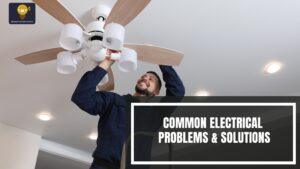Top 14 Critical Issues Only Skilled Electrical Repairers Should Handle
Many homeowners ignore hidden electrical faults and delay electrical repairs. These faults can cause shocks, fires, and high repair bills. You never know when a small issue will become major. Imagine a flickering light that suddenly sparks. Or a breaker that trips without reason. Those minor signs often point to serious hazards. Without action, you risk your family’s safety and your home’s value.
This guide covers 14 common electrical issues, each numbered. For every hazard, you’ll find warning signs, simple DIY checks, and advice on when to call professional electrical repairers. By reading on, you’ll learn how to protect your home with confidence.
Poor Circuit Protection (No RCCB)
Many homes lack an RCCB (Residual Current Circuit Breaker). Without it, minor faults can cause shocks or fires.
- Why It Matters: An RCCB trips instantly if it senses current leakage between live and neutral wires, stopping deadly shocks.
- How to Spot It: Open your breaker panel. If no breaker has a “Test” button, you lack RCCB protection.
- DIY Check: Press “Test” on any existing RCCB. If it doesn’t trip, call an electrician immediately.
- Professional Fix: Licensed electrical wiring services can install or upgrade your panel to include RCCBs that meet all safety codes.
- Benefit: An RCCB prevents shocks and reduces fire risks, especially in wet areas like kitchens and bathrooms.
2. Grounding Issues
Proper grounding gives fault currents a safe path to earth. Without it, appliance cases can become energized, causing shocks.
- Role of Grounding: It stabilizes voltage and protects against electric shocks by diverting fault current safely into the earth.
- Signs of Poor Grounding: A receptacle tester showing “Open Ground” or two-prong outlets indicates a missing ground path.
- DIY Test: Use a plug-in tester on each outlet. If it reports “Open Ground,” call an electrician.
- Professional Repair: Electrical wiring services can run a grounding conductor from the panel to the outlet or install a ground rod.
- Why Act: Properly grounded outlets protect electronics from voltage spikes and improve overall safety.
3. No GFCI Outlets
GFCI (Ground Fault Circuit Interrupter) outlets protect people in wet areas by tripping if current flows through water or a person.
- Importance of GFCI: It trips in milliseconds when it senses a ground fault, preventing severe shocks.
- Where to Install: Kitchens, bathrooms, garages, and outdoor outlets need GFCI. If these areas have standard outlets, they lack proper protection.
- Testing GFCI: Press “Test” monthly. If it fails or won’t reset, replace it immediately.
- DIY Caution: Installing a GFCI requires turning off the breaker and following wiring diagrams precisely. If unsure, hire electrical repairers.
- Professional Installation: A licensed electrician replaces old outlets with GFCI units and ensures code compliance.
4. Ungrounded Connections
Ungrounded connections often hide behind walls. That makes outlets or switch plates potentially “hot,” posing serious shock hazards.
- Cause: In older homes, builders sometimes omitted ground wires. DIY fixes may also miss grounding.
- Detection: Use a voltage tester on outlet plates. If metal parts glow or beep, the outlet may be energized.
- Quick Fix: Turn off the breaker, remove the outlet cover, and ensure the ground wire is attached to the outlet’s ground terminal. If no ground wire exists, call an electrician.
- Professional Repair: Electrical wiring services can run a new ground conductor from the panel to each outlet, using approved boxes and connectors.
- Long-Term Value: Proper grounding extends appliance life, improves surge protection, and enhances safety during storms.
5. Light Bulbs Burning Out Too Often
Frequent bulb failures usually indicate wiring problems. Loose socket contacts or voltage fluctuations shorten bulb life.
- Common Causes: Loose socket contacts, high voltage spikes, or poor insulation can overheat and kill bulbs.
- Initial Check: Turn off power, tighten the bulb base, and install a quality LED bulb of the correct wattage.
- Underlying Issue: If bulbs still burn out quickly, the fixture may have a loose neutral connection causing arcing.
- DIY Fix: If comfortable, turn off power and inspect fixture wiring. Tighten any loose nuts. Otherwise, call an electrical repairer.
- Professional Service: Electrical wiring services can replace corroded sockets and inspect above-ceiling wiring to ensure stable voltage.
6. Flickering or Dim Lights
Flickering or dim lights often stem from wiring faults. Overly bright fixtures may indicate voltage spikes.
- Single vs. Multiple Fixtures: If only one bulb flickers, the issue may be the socket or bulb. If several lights flicker, wiring or panel issues are likely.
- Voltage Drop: High-demand appliances (like AC units) draw large startup currents, causing brief voltage dips that dim lights.
- DIY Steps: Replace the bulb and test. If flickering continues, turn off the breaker and tighten wires in the fixture box.
- Professional Fix: Electrical repairers trace loose connections, secure terminal screws, replace damaged wires, or install dedicated circuits for heavy loads.
- Prevention: Install LED-compatible dimmer switches; LEDs draw less power and reduce flicker.
7. Electrical Shocks
Even a mild shock indicates a serious fault. Shocks often arise from damaged insulation or missing ground paths.
- Common Sources: Frayed appliance cords, loose outlet wiring, water near outlets, and missing ground wires.
- Immediate Action: Unplug the device, test another outlet, and stop using any device that still shocks you.
- Preventive Measure: Install GFCI or AFCI (Arc Fault Circuit Interrupter) outlets. These devices detect ground faults and arcs quickly, cutting power in milliseconds.
- Professional Check: Electrical wiring services can measure insulation resistance and confirm that outlets have proper ground paths.
- Why Fast Action Matters: Ignored shocks can escalate to lethal levels or damage expensive appliances.
8. Unexplained High Electricity Bills
Sudden spikes in your bill often hide behind wiring faults or phantom loads. Many devices draw power even when “off.”
- Phantom Load Defined: Devices like TVs, game consoles, and chargers draw standby power, which can inflate your bill over time.
- Wiring Faults That Leak Power: Damaged insulation or loose neutrals allow current to leak, boosting consumption.
- DIY Audit: Use a watt meter to measure device draw. Unplug all appliances overnight and compare meter readings in the morning to find baseline draw.
- Professional Energy Audit: Licensed electrical repairers can test for current leakage in walls and panels, then recommend energy-efficient upgrades.
- Saving Money: Switch old incandescent bulbs to LEDs and seal drafts around windows to reduce heating and cooling costs.
9. Power Surges
Surges are brief voltage spikes that can destroy electronics. Lightning, grid switching, and large motors starting often trigger them.
- Spotting Surge Damage: Look for melted fuses, burnt plug ends, or appliances that won’t power on.
- Immediate Response: Unplug sensitive devices (computers, TVs) during storms to break the surge path.
- Whole-House Protection: Installing a surge arrester at the main panel protects all circuits simultaneously.
- Point-of-Use Strips: Surge-protected power strips guard individual devices, but they offer limited protection compared to panel-mounted arresters.
- Professional Role: Electrical repairers test your grounding system and install a properly rated surge protector, ensuring your grounding electrode meets code.
10. Power Sags and Dips
Voltage sags occur when large appliances start. Lights may dim, and electronics might glitch briefly.
- Typical Triggers: Air conditioners, refrigerators, and welders draw high startup current, dropping the line voltage.
- Identifying Sags: Note which appliance runs when dimming occurs. If it coincides with AC cycling, that’s likely the cause.
- DIY Step: Use a clamp meter on the circuit while the appliance starts to measure voltage drops.
- Preventive Solution: Install a voltage regulator for sensitive electronics to maintain a steady voltage even if the main feed sags.
- Expert Help: Electrical repairers can rebalance circuit loads, adding breakers or redistributing appliances to reduce sags.
11. Overloading
Overload arises when you draw more current than a circuit can handle. Frequent breaker trips and warm outlets signal this issue.
- Common Culprits: Space heaters, window air conditioners, and power tools that draw high amperage.
- Spotting Overload: If a breaker trips under heavy load but resets under light load, it likely indicates overload.
- DIY Response: Unplug devices, reset the breaker, and plug items back one at a time to identify the load causing trips.
- Avoiding Overload: Never daisy-chain extension cords or power strips. Use heavy-duty cords rated for the tool’s amperage.
- Professional Upgrade: If overload persists, call electrical wiring services to install a dedicated circuit for heavy-draw appliances, reducing future trips.
12. Switches Not Working
A switch that won’t turn lights on often points to a wiring issue or a dead switch. In either case, it’s unsafe.
- Initial Check: Flip the breaker off and replace the bulb first. If still no light, the switch likely needs replacement.
- DIY Swap: Turn off the breaker, use a non-contact voltage tester, and then replace the switch with one of the same rating.
- Hidden Wiring Faults: Burn marks or melting around wire nuts behind the switch indicate a loose connection that can spark and cause heat.
- When to Call Pros: If you see charred insulation or hear sizzling behind the switch, stop and call licensed electrical repairers. Improper DIY can worsen hazards.
- Long-Term Fix: A licensed electrician rewires the switch box, secures all connections with approved wire nuts or screw terminals, and tests for proper function.
13. Uncovered Junction Boxes
An open junction box exposes live wires. Even a stray tool or curious child can cause a short or shock.
- Why Covers Matter: Covers contain sparks and keep dust or debris from entering. Exposed wires can shock anyone who touches them.
- DIY Fix: Shut off the main breaker, install a correctly sized cover for the box, and secure all wire splices with approved nuts.
- Professional Inspection: If multiple cables share a box, a licensed electrician confirms proper fill capacity and uses UL-approved connectors.
- Preventive Check: Inspect all ceiling fixtures and wall outlets annually for missing covers and replace them immediately.
14. Overloaded Panel (Overcircuited)
When too many breakers crowd a panel, loose connections and overheating result, and labeling becomes difficult.
- Warning Signs: Tandem breakers in half-size slots, empty knockout holes without plugs, and breakers that feel hot to the touch.
- Why It’s Dangerous: Loose breakers can arc at the bus bar, causing heat or fire. An unorganized panel makes tracing circuits nearly impossible.
- Professional Repair: Electrical wiring services upgrade your panel, arrange breakers properly, add a subpanel if needed, and clearly label every circuit.
- Benefit: A well-organized panel reduces overload risks, simplifies future electrical work, and boosts overall safety.
Conclusion
Small electrical issues can become serious if ignored. Check your home for these 14 problems to prevent shocks, fires, and high bills. Test GFCIs and RCCBs, verify grounding, and watch breaker activity. At the first sign of trouble—flickering lights, warm switches, or frequent trips—stop and call licensed electrical repairers. They provide reliable wiring and electrical repairing services. Protect your home, family, and budget by acting promptly.
Contact NT Electrician for expert electrical repairs and wiring services.




